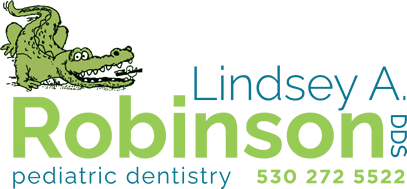


At what age should my child visit the dentist?
Lindsey A. Robinson, DDS in Grass Valley follows the American Academy of Pediatric Dentistry guidelines for a first visit by age 1. Visiting the dentist at an early age sets a positive foundation for a lifetime of dental visits, and helps you understand how to care for baby teeth and what to expect as your baby grows. These first visits not only help your child acclimate to a new environment and feel safe and comfortable, it’s also building a relationship between your family and your pediatric dentist. When a pediatric dental emergency occurs, you and your child will know whom to call and have the security of knowing your doctor.
Early visits to your Grass Valley, CA dentist can also help you identify any problem areas, pathologies or future issues that you may not be aware of, and set the course for your child’s dental health.
What is a pediatric dentist?
A pediatric dentist is a general dentist who has completed additional years of education and training, and has also completed a pediatric-focused residency in a hospital setting. A Board Certified Pediatric Dentist, or Diplomate, is a dentist who demonstrates an exceptional knowledge and expertise at a standard not possessed by other dentists. The certification process determines the proficiency of pediatric dentists using a written examination followed by an oral examination with the American Board of Pediatric Dentistry. Only about 47% of practicing pediatric dentists are board certified.
Why are baby teeth important?
Your child’s baby (primary) teeth help them develop physically, mentally and emotionally.
Physically, your child’s teeth help them chew, and provide placeholders as their permanent teeth grow and develop. If their primary teeth need to be extracted (pulled) before they are ready, it could indicate problems as they grow and when their permanent teeth are ready to erupt.
Your child’s teeth also assist their mental development. As children learn to form sounds, speak and communicate, their tongue, lips, cheeks and teeth are all part of sounding words correctly and learning to express their thoughts. Well-functioning teeth also help a child’s concentration; if they are in pain from a diseased tooth, research shows they perform poorly in school and can also develop other negative behaviors as a result of their discomfort.
We all appreciate a beautiful smile, and children are no different. Emotionally, children can struggle if they have noticeable disease and decayed teeth. Children are less likely to fully smile, and they can develop habits that follow them for a lifetime.
What is the best way to clean baby teeth?
When teeth are first breaking through the skin (erupting), a soft, damp washcloth should be wiped along the gums and teeth. This is especially important if you are nursing; each time you nurse your baby, you should clean their gums and teeth.
When teeth start to become fully erupted, switch to using a soft-bristled toothbrush. You can start using a very small smear of fluoride-free toothpaste on the brush, or none at all. When children are old enough to spit out toothpaste, we recommend switching to a fluoridated toothpaste. Toothpastes that contain xylitol are also highly recommended, as xylitol is a naturally-occurring sweetener that has been found to inhibit decay-causing bacteria in the mouth.
Remember that children need assistance with proper brushing techniques until they are able to accomplish fine motor skills, such as writing in cursive (age 7 or 8).
How much toothpaste should my child use?
For babies without teeth, gently wipe their gums with a damp washcloth or a xylitol wipe after nursing. As soon as teeth appear, decay can occur, so gentle brushing with a soft toothbrush and water after each meal is recommended.